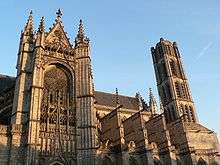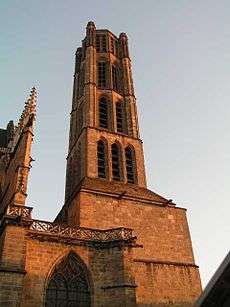Limoges Cathedral

Limoges Cathedral (Cathédrale Saint-Étienne de Limoges) is a Roman Catholic cathedral, and a national monument of France, situated in Limoges. It is the seat of the Bishop of Limoges.
The construction of the Gothic cathedral began in 1273 and finished only in 1888 when the nave was connected to the belltower. It is noted for its Renaissance rood loft built in 1534 and for the fine, partly octagonal, bell tower.
The main artistic works in the cathedral are the Renaissance rood screen, now moved to the western end of the nave, and the tomb of the bishop Jean de Langeac, with sculpted scenes of the Apocalypse.
Architecture


- Nave and choir, respectively, looking east, through a "folding out" lens that nearly flattens out the steep Gothic arches.
The cathedral contains two Renaissance works of great quality: a loft custom made by Bishop John Langeac, and the tomb of this bishop on which are carved scenes of the Apocalypse, inspired by Dürer.
The walls of Romanesque crypt have beautiful frescoes representing Christ in glory. Some medieval paintings are still visible in some chapels (including representatives of angelic musicians) but almost all are frescoes of the 19th century.
The Cathedral of Limoges has two organs. Hauptwerk, which was inaugurated by Gonzalez in 1963 and the Choir organ, installed in 1850.
Every summer, the association of the cathedral organizes organ concerts to highlight the major organs of this building.
Gallery
External links
| Wikimedia Commons has media related to Cathédrale Saint-Étienne de Limoges. |
Coordinates: 45°49′44″N 1°16′0″E / 45.82889°N 1.26667°E





